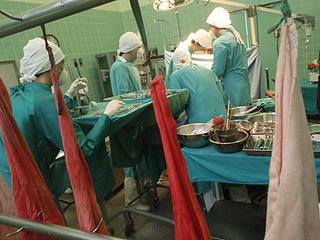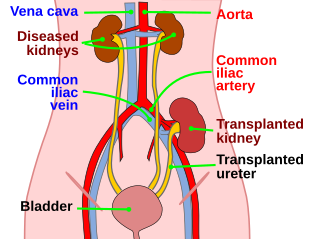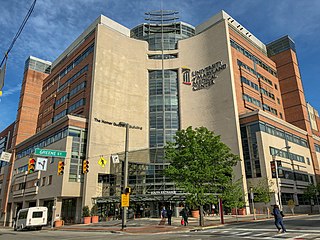Related Research Articles

Organ transplantation is a medical procedure in which an organ is removed from one body and placed in the body of a recipient, to replace a damaged or missing organ. The donor and recipient may be at the same location, or organs may be transported from a donor site to another location. Organs and/or tissues that are transplanted within the same person's body are called autografts. Transplants that are recently performed between two subjects of the same species are called allografts. Allografts can either be from a living or cadaveric source.

A pancreas transplant is an organ transplant that involves implanting a healthy pancreas into a person who usually has diabetes.

Caroli disease is a rare inherited disorder characterized by cystic dilatation of the bile ducts within the liver. There are two patterns of Caroli disease: focal or simple Caroli disease consists of abnormally widened bile ducts affecting an isolated portion of liver. The second form is more diffuse, and when associated with portal hypertension and congenital hepatic fibrosis, is often referred to as "Caroli syndrome". The underlying differences between the two types are not well understood. Caroli disease is also associated with liver failure and polycystic kidney disease. The disease affects about one in 1,000,000 people, with more reported cases of Caroli syndrome than of Caroli disease.

Liver transplantation or hepatic transplantation is the replacement of a diseased liver with the healthy liver from another person (allograft). Liver transplantation is a treatment option for end-stage liver disease and acute liver failure, although availability of donor organs is a major limitation. The most common technique is orthotopic transplantation, in which the native liver is removed and replaced by the donor organ in the same anatomic position as the original liver. The surgical procedure is complex, requiring careful harvest of the donor organ and meticulous implantation into the recipient. Liver transplantation is highly regulated, and only performed at designated transplant medical centers by highly trained transplant physicians and supporting medical team. The duration of the surgery ranges from 4 to 18 hours depending on outcome. Favorable outcomes require careful screening for eligible recipient, as well as a well-calibrated live or cadaveric donor match.

Xenotransplantation, or heterologous transplant, is the transplantation of living cells, tissues or organs from one species to another. Such cells, tissues or organs are called xenografts or xenotransplants. It is contrasted with allotransplantation, syngeneic transplantation or isotransplantation and autotransplantation.

Alagille syndrome is a genetic disorder that affects primarily the liver and the heart. Problems associated with the disorder generally become evident in infancy or early childhood. The disorder is inherited in an autosomal dominant pattern, and the estimated prevalence of Alagille syndrome is 1 in every 30,000 to 1 in every 40,000 live births. It is named after the French pediatrician Daniel Alagille, who first described the condition in 1969.

Kidney transplant or renal transplant is the organ transplant of a kidney into a patient with end-stage kidney disease (ESRD). Kidney transplant is typically classified as deceased-donor or living-donor transplantation depending on the source of the donor organ. Living-donor kidney transplants are further characterized as genetically related (living-related) or non-related (living-unrelated) transplants, depending on whether a biological relationship exists between the donor and recipient.

Hepatorenal syndrome is a life-threatening medical condition that consists of rapid deterioration in kidney function in individuals with cirrhosis or fulminant liver failure. HRS is usually fatal unless a liver transplant is performed, although various treatments, such as dialysis, can prevent advancement of the condition.
Vladimir Petrovich Demikhov was a Soviet scientist and organ transplantation pioneer, who performed several transplants in the 1940s and 1950s, including the transplantation of a heart into an animal and a heart–lung replacement in an animal. He is also well known for his dog head transplants, which he conducted during the 1950s, resulting in two-headed dogs. This ultimately led to the head transplants in monkeys by Dr. Robert White, who was inspired by Demikhov's work.
Organ procurement is a surgical procedure that removes organs or tissues for reuse, typically for organ transplantation.

The University of Maryland Medical Center (UMMC) is a teaching hospital with 757 beds based in Baltimore, Maryland, that provides the full range of health care to people throughout Maryland and the Mid-Atlantic region. It gets more than 35,000 inpatient admissions and 165,000 outpatient visits each year. UMMC has approximately 6,500 employees as well as 1,000 attending physicians, and provides training for about half of Maryland's physicians and other health care professionals. All members of the medical staff are on the faculty of the University of Maryland School of Medicine.
Transplantable organs and tissues may both refer to organs and tissues that are relatively often or routinely transplanted, as well as relatively seldom transplanted organs and tissues and ones on the experimental stage.
Ovarian tissue cryopreservation is cryopreservation of tissue of the ovary of a female.
Tomoaki Kato, M.D., is a noted pioneer in multiple-organ transplantation, pediatric and adult liver transplantation. Kato is Surgical Director of Adult and Pediatric Liver and Intestinal Transplantation at NewYork-Presbyterian Hospital/Columbia University Medical Center and is a professor of surgery at Columbia University College of Physicians and Surgeons. Kato is also known for unique and innovative surgeries for adults and children, including a six-organ transplant; a procedure called APOLT that resuscitates a failing liver by attaching a partial donor liver, making immunosuppressant drugs unnecessary; and the first successful human partial bladder transplantation involving the transplant of two kidneys together with ureters connected to a patch of the donor bladder. In a highly publicized case, he led the first reported removal and re-implantation, or auto-transplantation, of six organs to excise a hard-to-reach abdominal tumor. Previously the director of pediatric liver and gastrointestinal transplant and professor of clinical surgery at the University of Miami School of Medicine, Kato received his medical degree from the Osaka University Medical School in Japan and received his residency training in surgery at Osaka University Hospital and Itami City Hospital in Hyogo, Japan. He completed a clinical fellowship in transplantation at the University of Miami/Jackson Memorial Hospital, in Miami, Florida, where he was subsequently appointed to the surgical faculty in 1997, and promoted to full professor in 2007. He served as a surgeon and senior leader of the liver and transplantation center at Miami's Jackson Memorial Hospital, beginning in 1997, and at University of Miami Hospital, beginning in 2004. Kato is a member of numerous professional and honorary organizations, and the author or co-author of more than 180 scientific papers in peer-reviewed journals.
Sander S. Florman, M.D., is an American transplant surgeon and Director of the Recanati/Miller Transplantation Institute at The Mount Sinai Hospital in New York City. He is a member of the American Society of Transplant Surgeons, the American Hepato-Pancreato-Biliary Association, the American Society of Transplantation and the American College of Surgeons.

A heart transplant, or a cardiac transplant, is a surgical transplant procedure performed on patients with end-stage heart failure or severe coronary artery disease when other medical or surgical treatments have failed. As of 2018, the most common procedure is to take a functioning heart, with or without both lungs, from a recently deceased organ donor and implant it into the patient. The patient's own heart is either removed and replaced with the donor heart or, much less commonly, the recipient's diseased heart is left in place to support the donor heart.
ABO-incompatible (ABOi) transplantation is a method of allocation in organ transplantation that permits more efficient use of available organs regardless of ABO blood type, which would otherwise be unavailable due to hyperacute rejection. Primarily in use in infants and young toddlers, research is ongoing to allow for increased use of this capability in adult transplants. Normal ABO-compatibility rules may be observed for all recipients. This means that anyone may receive a transplant of a type-O organ, and consequently, type-O recipients are one of the biggest beneficiaries of ABO-incompatible transplants. While focus has been on infant heart transplants, the principles generally apply to other forms of solid organ transplantation.

Paolo Brenner is a German physician and a professor of cardiac surgery at the Dept. of Cardiac Surgery, Klinikum Großhadern of the Ludwig Maximilian University of Munich (LMU). He is known for his work in the fields of xenotransplantation, the advancement of artificial hearts, extracorporeal membrane oxygenation (ECMO) and lung transplantation.
Organ donation is when a person gives their organs after they die to someone in need of new organs. Transplantation is the process of transplanting the organs donated into another person. This process extends the life expectancy of a person suffering from organ failure. Unfortunately the number of patients requiring organ transplants outweighs the number of donor organs available.
Jack Greene Copeland is an American cardiothoracic surgeon, who has established procedures in heart transplantation including repeat heart transplantation, the implantation of total artificial hearts (TAH) to bridge the time to heart transplant, innovations in left ventricular assist devices (LVAD) and the technique of "piggybacking" a second heart in a person, while leaving them the original.
References
- ↑ Musquera, M.; Peri, L. L.; Alvarez-Vijande, R.; Oppenheimer, F.; Gil-Vernet, J. M.; Alcaraz, A. (2010). "Orthotopic Kidney Transplantation: An Alternative Surgical Technique in Selected Patients". European Urology. 58 (6): 927–933. doi:10.1016/j.eururo.2010.09.023. PMID 20888120.